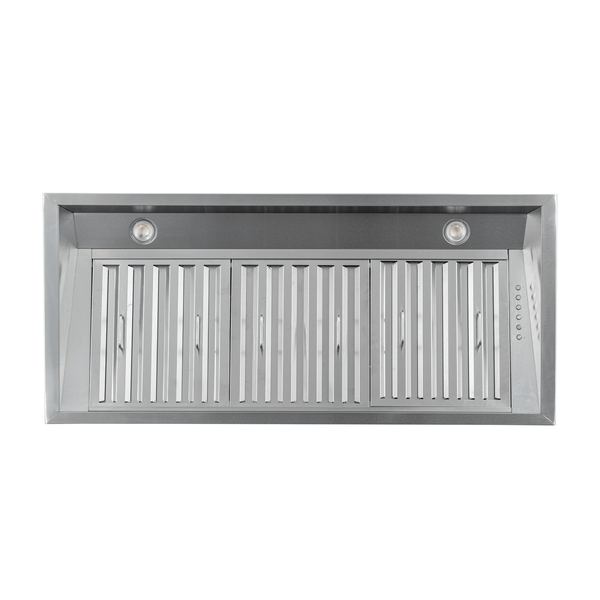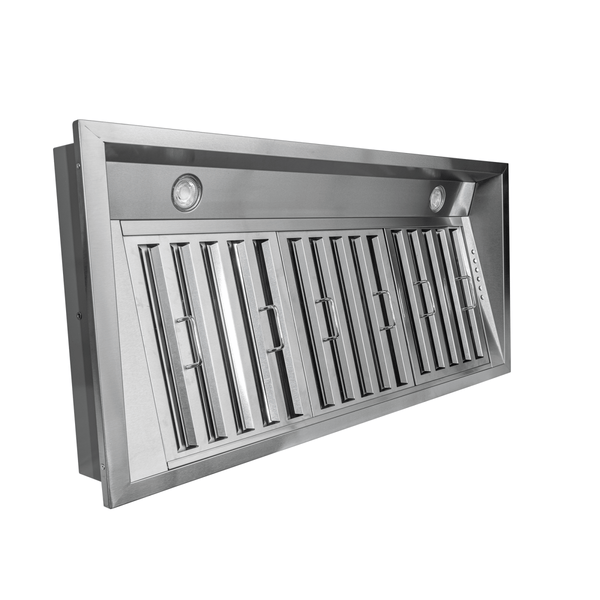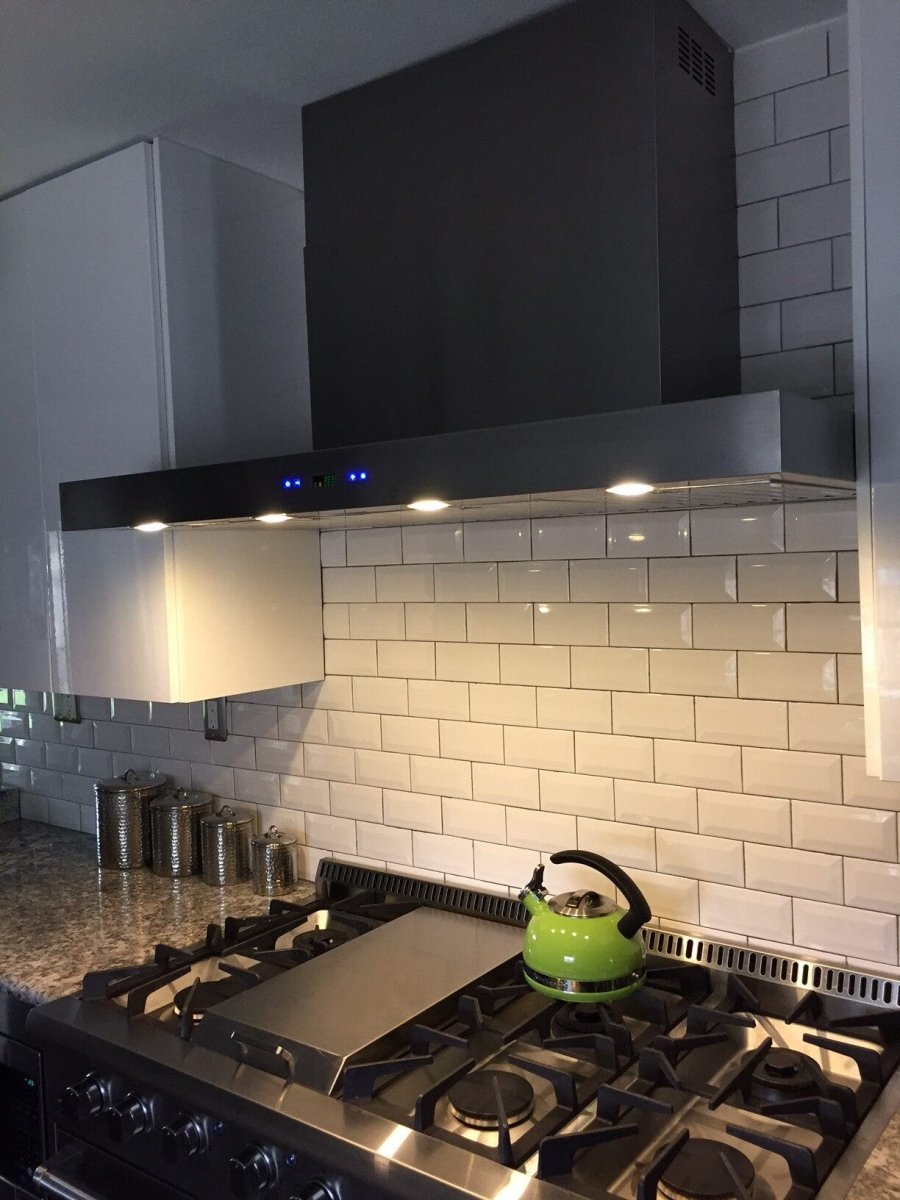Yes, a range hood damper will help prevent leaves, small animals, other debris, and hot or cold air from entering your ductwork and home from outside; it will also prevent backdrafting, which occurs when the dirty, greasy air in your ductwork travels back into your home by way of gravity or air restriction.
Range Hood Damper Location
A range hood damper can be located near your interior wall right inside your ductwork, inline with your ductwork, or you can purchase a wall or roof cap that comes with a range hood damper.
If you want to prevent debris or small animals from entering into your ductwork from the outside, consider purchasing a wall or roof cap or installing your damper closer to the outside wall of your home.
However, if you’re concerned more about backdrafting, install your damper close to the interior wall, where your range hood connects to the ductwork.
How does a range hood damper work?
A range hood damper is situated inside your ductwork. It opens when you turn your range hood on to allow for airflow and closes when you turn your range hood off. This prevents backdrafting and keeps any large debris from getting inside your ductwork or into your range hood or vent hood.
Where can I buy a range hood damper?
To purchase a range hood damper, take a look on Amazon.
You can also check out Lowe’s or Home Depot’s website.
If you can’t find the right range hood damper for you in those places, check with your local HVAC companies.
How do you install a range hood damper?
Installing your range hood damper is easy. It only takes a couple of minutes; watch the video below.
Do I need makeup air for my range hood?
If you’re in the market for a range hood, you also may be wondering if you need make-up air. In general, if you own a 900+ CFM range hood that you turn on for multiple hours every day, you’ll likely require make-up air – especially if your kitchen is small.
And that’s the other factor: size. If you operate a high-CFM range hood in a small kitchen, consider investing in a make-up air kit to replace the air that your hood is pulling out of your home. You can read more about makeup air here.
If you need a makeup air kit for your range hood, buy one on Amazon here.
How do I choose a range hood fan?
When choosing range hood fans, or blowers, you have two things to consider: power and the number of blowers. At Proline Range Hoods, our range hoods come with one or two blowers – single or dual. Our new PLJW 121 60” model, however, features four blowers and runs at 1800 CFM.
To understand more about finding the right CFM for your hood, take a look at these articles:
How many CFM do I need for my range hood?
Range Hood CFM for Electric vs. Gas Cooktops

How much does it cost to put in a range hood?
In general, range hood installation costs between $200 and $500, depending on the style: wall, island, or under cabinet. For more information on the average cost of range hood installation, check out this article.
Can a range hood be vented into my attic?
No. Do not vent your range hood into your attic. Otherwise, the unwanted contaminants from your kitchen air will not leave your home but simply accumulate in your attic. This results in high humidity in your attic as well, which may damage your attic, as well as poor indoor air quality.
Instead, vent your range hood to the outside to ensure that the grease, dirt, and chemicals exit your home.
How far can you vent a range hood?
The longest you should consider venting your range hood is about 30 feet. When installing ductwork for your range hood, keep in mind that shorter is always better. The shorter your ductwork, the quicker the dirty air will travel outside your home.
Also, avoid multiple turns in your ductwork. Each turn in your ductwork adds a little resistance, slowing down the flow of air outside your home. We recommend having as few bends in the ducting as possible as well. And don’t install any bends with less than 18” between them.
Since the air slows down, you have to shorten the length of the ductwork to ensure that the air reaches the outside of your home. In general, reduce your ductwork by 5’ for every 90-degree turn.
Can I use flexible duct for my range hood?
No. Flexible ductwork does not last very long, it is difficult to clean, and it is made of cheap material. Air doesn’t flow through it smoothly compared to rigid ductwork.
You’ll find yourself replacing your flexible ductwork when rigid ductwork would have lasted three or four times as long. So instead, consider the more durable rigid ductwork. It won’t require any cleaning as long as you maintain your range hood (if yours does, click here to learn how to clean your range hood duct) and is made of a stronger material.
Is it better for me to have a ducted hood or ductless hood?
In terms of cleaning your air efficiently, ducted range hoods. Ducted hoods are vented to the outside, so all of the harmful contaminants inside your home will leave that space, keeping you and your family healthy.
In contrast, a ductless hood simply takes the air inside the range hood and pushes it back into your house (recirculates it) through charcoal filters. So, the air is a little cleaner, but it still may contain some grease or dirt.
Although this isn’t ideal, some places such as apartments or condos don’t allow for ducted hoods. You may, for example, live on the third story of a 10-story complex. In this case, any hood is better than no hood, so consider purchasing a ductless hood.
Here is a more in-depth article about the differences and how to make that decision.
Hopefully, these questions helped you learn more about your range hood or vent hood’s damper. Consider investing in a range hood damper if you haven’t yet; it’ll keep both your ductwork and kitchen air clean. Have fun shopping!
We don’t sell range hood dampers but check out Amazon, your local Home Depot, or Lowe’s. If you are having trouble finding a range hood damper, call us at (877) 901-5530 and we can help you find what you need.
If you have found any of our blog content helpful in any way, please leave us a review on Yelp or Google. It only takes 10 seconds.
As an Amazon Associate, we earn from qualifying purchases.
Do I need a damper for my range hood?
How does a range hood damper work?
Where can I buy a range hood damper?
You can also check out Lowe’s or Home Depot’s website.
If you can’t find the right range hood damper for you in those places, check with your local HVAC companies.
How do you install a range hood damper?
Do I need makeup air for my range hood?
And that’s the other factor: size. If you operate a high-CFM range hood in a small kitchen, consider investing in a make-up air kit to replace the air that your hood is pulling out of your home. You can read more about makeup air here.
How do I choose a range hood fan?
How much does it cost to put in a range hood?
Can a range hood be vented into my attic?
Instead, vent your range hood to the outside to ensure that the grease, dirt, and chemicals exit your home.
How far can you vent a range hood?
Also, avoid multiple turns in your ductwork. Each turn in your ductwork adds a little resistance, slowing down the flow of air outside your home. We recommend having as few bends in the ducting as possible as well. And don’t install any bends with less than 18” between them.
Since the air slows down, you have to shorten the length of the ductwork to ensure that the air reaches the outside of your home. In general, reduce your ductwork by 5’ for every 90-degree turn.
Can I use flexible duct for my range hood?
You’ll find yourself replacing your flexible ductwork when rigid ductwork would have lasted three or four times as long. So instead, consider the more durable rigid ductwork. It won’t require any cleaning as long as you maintain your range hood (if yours does, click here to learn how to clean your range hood duct) and is made of a stronger material.
Is it better for me to have a ducted hood or ductless hood?
In contrast, a ductless hood simply takes the air inside the range hood and pushes it back into your house (recirculates it) through charcoal filters. So, the air is a little cleaner, but it still may contain some grease or dirt.
Although this isn’t ideal, some places such as apartments or condos don’t allow for ducted hoods. You may, for example, live on the third story of a 10-story complex. In this case, any hood is better than no hood, so consider purchasing a ductless hood.












